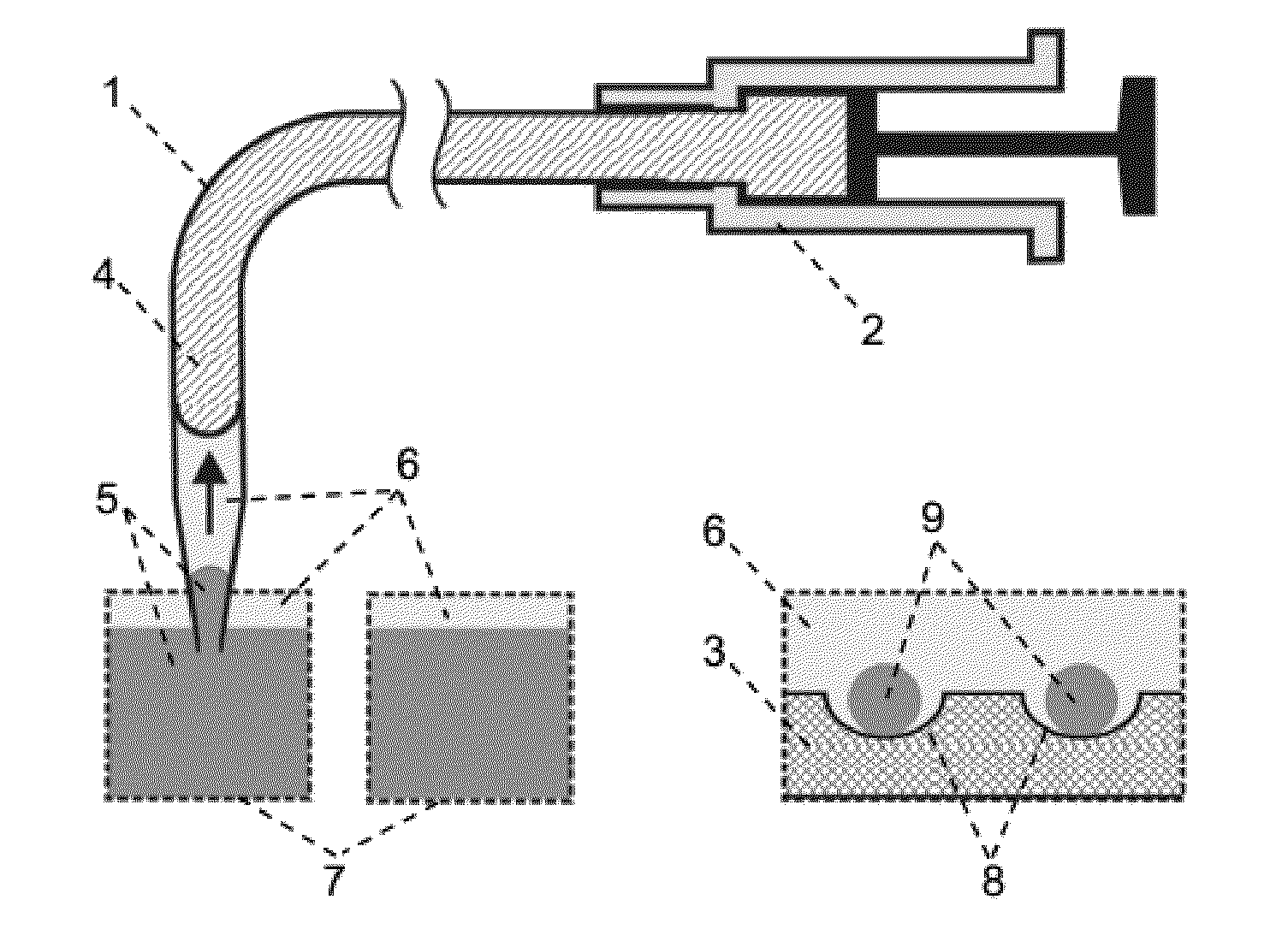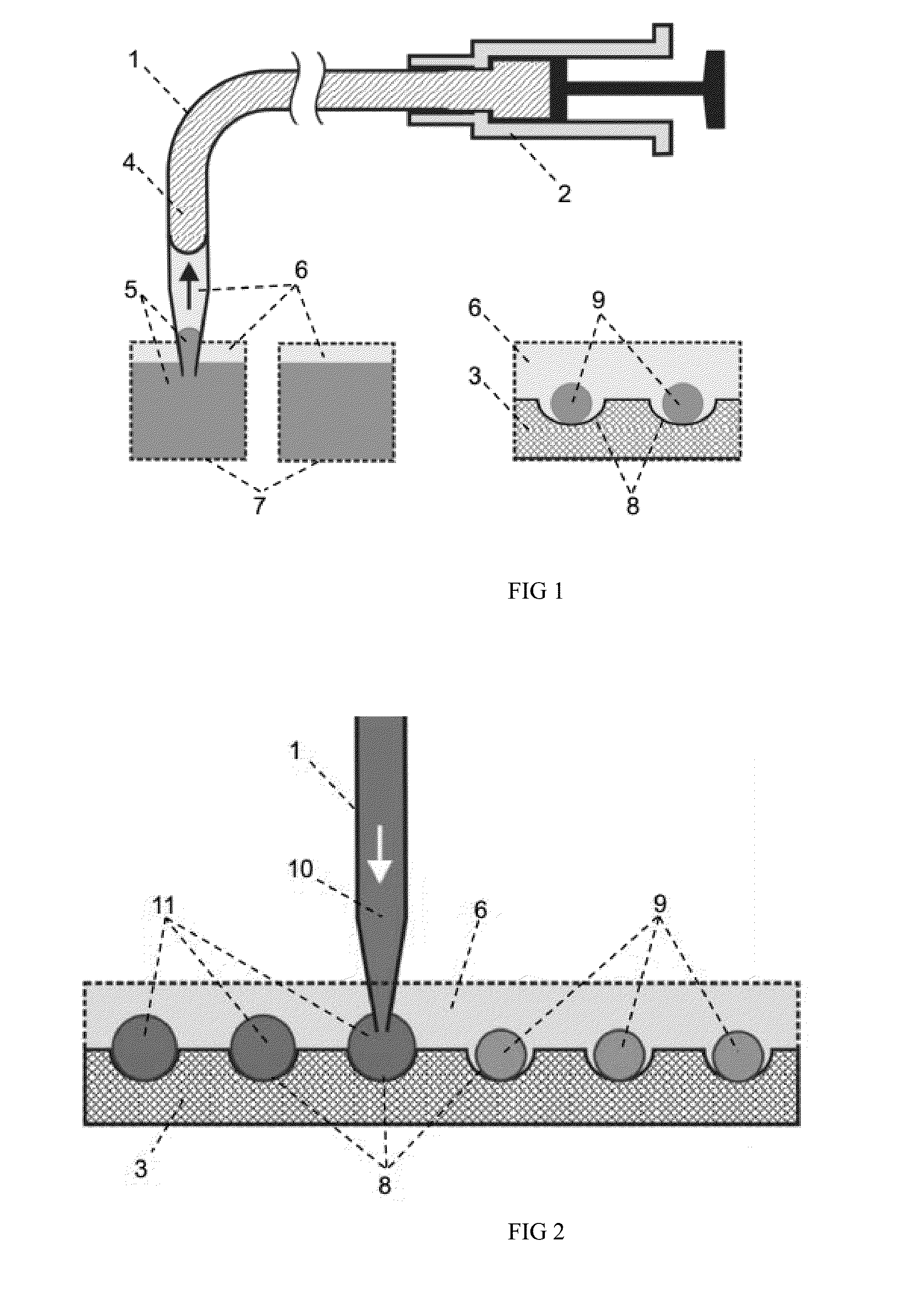An application method for automatic micro droplet array screening system with picoliter scale precision
a technology of automatic droplet array and screening system, which is applied in the field of highthroughput screening, can solve the problems of high cost, lack of manipulation techniques and devices, and the increasing difficulty of screening system, and achieve the effects of saving test cost, effective reducing sample/reagent consumption, and improving screening throughpu
- Summary
- Abstract
- Description
- Claims
- Application Information
AI Technical Summary
Benefits of technology
Problems solved by technology
Method used
Image
Examples
embodiment 1
[0058]FIG. 3 is the aerial fluorescent image for screening of enzyme inhibitor according to the droplet array screening system and its application method as shown in FIGS. 1 and 2 by taking 32 small-molecule compounds as samples for screening and Caspase-1 as the screening target. Firstly, 100 μM small-molecule compounds were placed into the sample / reagent storage tubes. The droplets of 32 small-molecule compounds were generated on the microwell array chip with the droplet array generation method as shown in FIG. 1. The volume of each droplet is 180 picoliters. After that, 180 picoliters of Caspase-1 enzyme (6 mU / μL) and substrate (Z-YVAD-R110) solution (20 μM) were respectively injected into each droplet according to the reagent injection method as shown in FIG. 2 to activate reaction. The incubation of microwell array chip was conducted at the temperature of 35° C., and the test results were obtained by means of fluorescence imaging. The test results were analyzed. Higher inhibiti...
embodiment 2
[0059]FIG. 4 is the recording chart showing measured half maximal inhibitory concentration (IC50) of compound 28 against Caspase-1 enzyme . First, the compound 28 with concentrations of 0.1 nM, 1 nM, 10 nM, 100 nM, 1 μM and 10 μM was added into the sample / reagent storage tubes, respectively. Droplets (180 picoliters) of compound 28 with different concentrations were generated on the microwell array chip with the droplet array screening system and its application method as shown in FIGS. 1 and 2, and 180 picoliters of Caspase-1 enzyme (6 mU / μL) and substrate (Z-YVAD-R110) solution (20 μM) were respectively injected into each droplet to activate reaction. Extraction and normalization of fluorescence value were conducted with reference to the fluorescence image as obtained with the method in Embodiment 1. The logarithmic processing of the concentrations of compound 28 was conducted for plotting the obtained results together with normalized fluorescence values corresponding to the conce...
embodiment 3
[0060]FIG. 5 is the recording chart showing results of screening of protein crystallization conditions by droplet array screening system in nanoliter scale. First, 50 mg / mL lysozyme sample solution and precipitant solutions containing 51 chemical compositions (Crystal crystallization kit from Hampton Company of the U.S.) were added into the sample / reagent storage tubes, respectively. 51 precipitant droplets with volume of 2 nL were generated on the microwell array chip with the droplet array generation method as shown in FIG. 1. Each precipitant condition was repeated for 5 times. After that, 2 nL lysozyme sample solution was respectively injected into each droplet to form crystallization reactors. The chip was placed into a 16° C. incubator for incubation. To prevent evaporation of micro droplets during prolonged incubation, liquid paraffin or mineral oil with poor permeability was selected as the oil phase during test. Finally, the droplet array was examined and imaged with the he...
PUM
| Property | Measurement | Unit |
|---|---|---|
| flow rate | aaaaa | aaaaa |
| thickness | aaaaa | aaaaa |
| volume | aaaaa | aaaaa |
Abstract
Description
Claims
Application Information
 Login to View More
Login to View More - R&D
- Intellectual Property
- Life Sciences
- Materials
- Tech Scout
- Unparalleled Data Quality
- Higher Quality Content
- 60% Fewer Hallucinations
Browse by: Latest US Patents, China's latest patents, Technical Efficacy Thesaurus, Application Domain, Technology Topic, Popular Technical Reports.
© 2025 PatSnap. All rights reserved.Legal|Privacy policy|Modern Slavery Act Transparency Statement|Sitemap|About US| Contact US: help@patsnap.com



